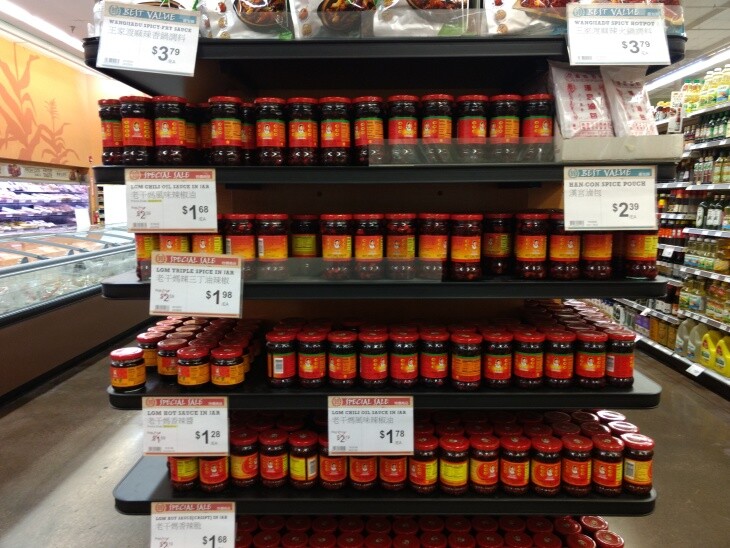Truth matters. Community matters. Your support makes both possible. LAist is one of the few places where news remains independent and free from political and corporate influence. Stand up for truth and for LAist. Make your year-end tax-deductible gift now.
Lao Gan Ma, The Most Popular Hot Sauce In China, Is Coming To Walmart

Mexico has Cholula.* Korea has gochujang. Southern California has Sriracha, the pride and joy (and occasional source of conflict) of Irwindale. In China, when people want to bring the heat, they turn to Lao Gan Ma, the country's best-selling hot sauce.
With its signature red label featuring an image of its unsmiling founder, each jar of Lao Gan Ma (direct translation: the godmother) contains a mix of chili flakes and onions soaked in soybean oil and some combo of garlic, fermented cabbage, mushrooms and black beans, depending on the varietal. The company makes two dozen chili-based condiments but its first, most basic chili oil remains its best seller with some 2 million bottles of the stuff produced daily at its homebase, in Southwest China.

Thanks to the ever expanding Chinese diaspora, Lao Gan Ma has become a staple on the shelves of the San Gabriel Valley's Asian grocery stores. Now, it wants to dominate the hot sauce aisles in the rest of America's supermarkets.
You can thank Tao Huabi, the woman who started it all. Growing up poor in a rural village in China's Guizhou province, she wanted something better. In 1989, at age 42, she opened a hole-in-the-wall noodle shop in the capital city of Guiyang, where she served her homemade chili oil alongside the food. The sauce, a mix of peppers, spices and fermented soybeans, outshone everything else on the menu. Tao went all in, founding Lao Gan Ma in 1996.

The first bottles of her product arrived in the United States less than a decade later, in the early 2000s. Like many popular foreign foods, the demand was driven by immigrants who craved a taste of their homeland. As America's Chinese population grew, sales of Lao Gan Ma boomed. Today, the 71-year-old Tao is reportedly worth more than $1 billion.
Eddy Xu, who manages LGM USA, the company's U.S. distribution and marketing arm, says they went from importing 10 cargo containers full of the stuff in early 2000s to ten times that amount this year. Along the way, Lao Gan Ma has inspired a cult following, one that extends beyond the Chinese diaspora.
At New York Fashion Week this month, Tao became an unlikely star when images of her face popped up on hoodies from Opening Ceremony. Don't feel like paying $120 for a sweatshirt? Don't worry, you can probably pick one up for $10 on Canal Street right now.
my hypebeast cousin was not impressed with the opening ceremony 老干妈 hoodies... now that’s spicy 🌶 pic.twitter.com/PgUx7z04kq
— 🐢 (@smashedmcdouble) September 13, 2018
Becoming a fleeting fashion icon is all well and good but Tao and her company have their sights set on a loftier goal. "All the Asian Chinese like the Lao Gan Ma but not people in the mainstream," Xu says.
He's on a mission to change that. Working from the company's recently established satellite office in Irwindale, Xu wants to make Lao Gan Ma a household name in the U.S. The first step? Walmart, of course.
Later this month, the mega-retailer will start selling Lao Gan Ma in 400 of its brick-and-mortar stores, probably in areas with a significant Asian American population. After that, the company is eyeing Kroger and Costco. Eventually, Xu wants to get the sauce into the hands of non-Chinese chefs and restaurateurs.
Lao Gan Ma, in addition to its array of chili oils, produces bean paste, pickled vegetables, fermented bean curd and a hot pot soup base. Fans of the chili oil use it on just about everything, from fried eggs and dumplings to hot dogs and pizzas. Purists heap onto plain white rice so they can savor it, unsullied by other flavors.
Whether or not the company achieves mainstream domination, its legion of fans remain devoted. The condiment's unrivaled popularity has spawned a saying in China: "Wherever there are Chinese people, there's Lao Gan Ma." With nearly 4 million Chinese and Chinese American people living in the U.S., the Godmother knows: Success is a dish best served cold — preferably with a heaping spoonful of fiery chili oil.








